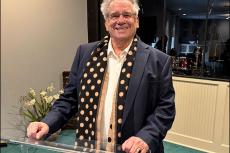This book, from the East Hampton Town Historic Records, recorded each unique livestock earmark in East Hampton and to whom the mark was registered.
Earmarks are small cutouts punched into a livestock animal’s ear when it is young, communicating important information, usually to whom the animal belongs. These were required by law in the American colonies as early as 1644 in Connecticut. East Hampton’s earmark log was faithfully kept by the town clerk. In 1830, when the page seen here was written, Jonathan S. Conklin (1771-1839) filled that role.
At the time, earmarks were considered the least painful or dangerous way of identifying livestock that wandered unsupervised, grazing on common lands. With so many cattle grazing in the remote fields of Montauk, earmarks prevented free-roaming cattle from being misidentified or stolen. Common designs here included a crop, slope, halfpenny, ell, or slit.
Because cattle earmarks were prescribed to specific locations, with specific designs, the possible combinations were inevitably limited. As a result, new farmers could buy another farmer’s mark, along with any cattle bearing that mark. This was an added item a farmer could sell later in life if he chose to scale back on farming activity. Other existent marks were given as gifts or inherited within families. On the page shown here, William H. Dayton (1810-1899) receives a mark from his father, Jeremiah Dayton (d. 1867), as was often done.
Today, ear tags, dye, and electronic methods of marking are increasingly popular with livestock farmers, although earmarking is still practiced.
While it may seem strange to the Hamptons of 2023, wandering livestock were a normal sight in this area for centuries. Much of eastern Long Island’s economy was tied to raising livestock for the sugar islands of the Caribbean, where land was too valuable to waste on crops less lucrative than sugar, as the Plain Sight Project has illuminated.
—
Moriah Moore is a librarian and archivist in the East Hampton Library’s Long Island Collection.




